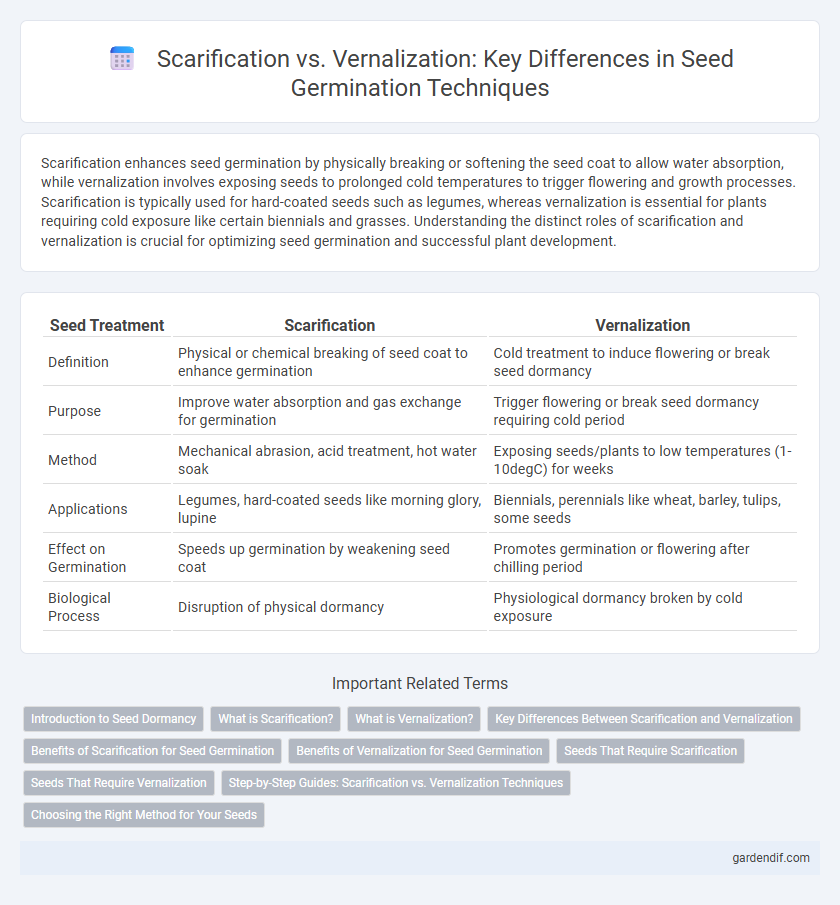
Scarification vs Vernalization Illustration
Scarification enhances seed germination by physically breaking or softening the seed coat to allow water absorption, while vernalization involves exposing seeds to prolonged cold temperatures to trigger flowering and growth processes. Scarification is typically used for hard-coated seeds such as legumes, whereas vernalization is essential for plants requiring cold exposure like certain biennials and grasses. Understanding the distinct roles of scarification and vernalization is crucial for optimizing seed germination and successful plant development.
Table of Comparison
| Seed Treatment | Scarification | Vernalization |
|---|---|---|
| Definition | Physical or chemical breaking of seed coat to enhance germination | Cold treatment to induce flowering or break seed dormancy |
| Purpose | Improve water absorption and gas exchange for germination | Trigger flowering or break seed dormancy requiring cold period |
| Method | Mechanical abrasion, acid treatment, hot water soak | Exposing seeds/plants to low temperatures (1-10degC) for weeks |
| Applications | Legumes, hard-coated seeds like morning glory, lupine | Biennials, perennials like wheat, barley, tulips, some seeds |
| Effect on Germination | Speeds up germination by weakening seed coat | Promotes germination or flowering after chilling period |
| Biological Process | Disruption of physical dormancy | Physiological dormancy broken by cold exposure |
Introduction to Seed Dormancy
Seed dormancy is a vital adaptive mechanism that prevents germination under unfavorable conditions, ensuring plant survival. Scarification physically alters the seed coat to overcome mechanical barriers, while vernalization exposes seeds to prolonged cold to break physiological dormancy. Understanding these processes optimizes germination timing and enhances seedling establishment in agricultural and ecological contexts.
What is Scarification?
Scarification is a seed treatment method that involves physically breaking, scratching, or softening the seed coat to enhance water absorption and accelerate germination. This technique is essential for seeds with hard or impermeable outer layers, such as legumes and certain trees, which naturally require mechanical disruption to sprout. By improving moisture penetration, scarification significantly increases germination rates and shortens dormancy periods in seeds that would otherwise remain dormant in natural conditions.
What is Vernalization?
Vernalization is the process of exposing seeds or plants to prolonged cold temperatures to stimulate flowering and improve germination rates. This cold treatment triggers genetic and physiological changes that break seed dormancy, ensuring synchronized plant development in spring. Vernalization is essential for many cereal crops and biennial plants, enhancing agricultural productivity and crop yield.
Key Differences Between Scarification and Vernalization
Scarification involves physically breaking or weakening a seed's outer coating to promote germination, while vernalization requires exposing seeds or plants to a prolonged period of cold to trigger flowering or germination. Scarification is primarily a mechanical or chemical process targeting seed dormancy caused by hard seed coats, whereas vernalization addresses physiological dormancy linked to temperature-dependent developmental cues. The key difference lies in scarification facilitating water absorption by altering seed coat permeability, whereas vernalization influences internal hormonal changes induced by cold exposure.
Benefits of Scarification for Seed Germination
Scarification enhances seed germination by physically breaking or softening the seed coat, which promotes water absorption and gas exchange, essential for embryo development. This method is particularly effective for hard-coated seeds like legumes and certain tree species, ensuring faster and more uniform sprouting. Unlike vernalization, scarification directly modifies seed coat permeability, bypassing chilling requirements and accelerating germination under favorable conditions.
Benefits of Vernalization for Seed Germination
Vernalization enhances seed germination by exposing seeds to prolonged cold, breaking dormancy and synchronizing sprouting with favorable spring conditions. This process improves uniformity and accelerates seedling emergence, leading to stronger initial growth and better yield potential. Unlike scarification, which mechanically breaks seed coats, vernalization harnesses natural temperature cues to optimize developmental timing.
Seeds That Require Scarification
Seeds that require scarification possess hard seed coats that prevent water and gas uptake, delaying germination until the coat is physically broken or weakened. Common examples include legume seeds like acacia, mimosa, and lupine, which benefit from mechanical abrasion, hot water treatment, or acid exposure to trigger successful germination. Scarification effectively mimics natural processes such as animal digestion or fire, ensuring timely seedling emergence in species adapted to harsh or variable environments.
Seeds That Require Vernalization
Seeds that require vernalization must undergo a prolonged exposure to cold temperatures to break dormancy and initiate germination, a process critical for species adapted to temperate climates. Unlike scarification, which mechanically or chemically alters the seed coat to enhance water absorption, vernalization triggers internal physiological changes by mimicking winter conditions. Examples of seeds requiring vernalization include biennial plants such as carrots, beets, and some species of wheat and ryegrass.
Step-by-Step Guides: Scarification vs. Vernalization Techniques
Scarification involves physically breaking, scratching, or softening the seed coat to enhance water absorption and germination, typically using sandpaper, nicking with a knife, or soaking seeds in hot water. Vernalization requires exposing seeds or seedlings to a prolonged period of cold temperatures, often between 1-7degC, to simulate winter conditions and trigger flowering or growth development. Implement scarification before planting by treating seeds, while vernalization can be done by chilling seeds in moist conditions inside a refrigerator for several weeks.
Choosing the Right Method for Your Seeds
Scarification and vernalization serve distinct purposes in seed germination: scarification breaks tough seed coats to enable water absorption, while vernalization exposes seeds to cold temperatures to trigger flowering. Selecting the right method depends on seed type--hard-coated seeds like sweet peas benefit from scarification, whereas biennials and perennials such as carrots require vernalization. Understanding species-specific needs ensures effective germination and healthy seedling development.
Scarification vs Vernalization Infographic

 gardendif.com
gardendif.com